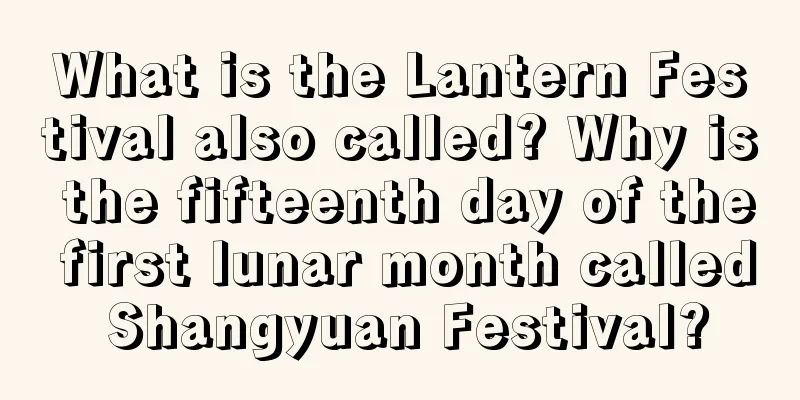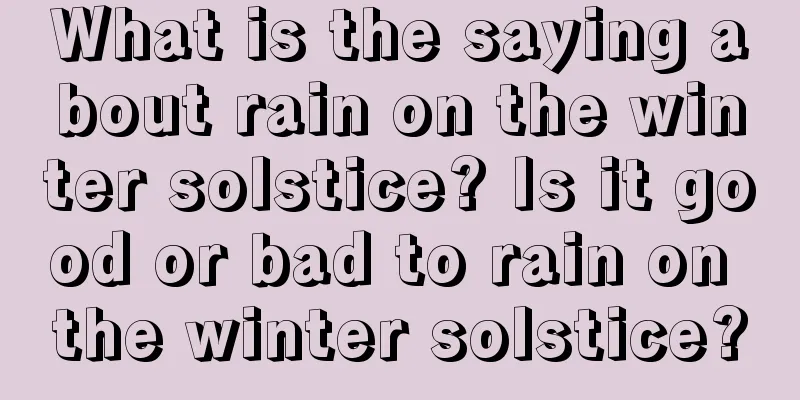What is the Lantern Festival also called? Why is the fifteenth day of the first lunar month called Shangyuan Festival?

|
The Lantern Festival on the 15th day of the first lunar month is the first important festival after the Chinese New Year. People have the tradition of eating Yuanxiao (glutinous rice balls) on that day. The first month of the lunar calendar is the first month of the year. The ancients called the night "xiao", so the fifteenth day of the first month is called the Lantern Festival. So, what is the Lantern Festival on the 15th day of the first lunar month also called? What is the Lantern Festival also called? The Lantern Festival, also known as the "Shangyuan Festival, Spring Lantern Festival, is a traditional Chinese folk festival. The first month of the lunar calendar is the first month of the lunar calendar, which the ancients called "xiao", and the fifteenth day is the first full moon night of the year, so the fifteenth day of the first month is called the Lantern Festival. It is also called the Little New Year, Yuanxiao or Lantern Festival, and is the first important festival after the Spring Festival. Why is the fifteenth day of the first lunar month called the Lantern Festival? The main activity of the Lantern Festival on the fifteenth day of the first lunar month is eating glutinous rice dumplings and admiring the moon at night. Yuanxiao originally meant "the night of the Lantern Festival". Later, after evolution, "Lantern Festival" was called "Lantern Festival". On the night of the Lantern Festival, the streets and alleys are decorated with lights, people admire the lanterns, guess lantern riddles, and eat Lantern Festival rice dumplings, bringing the celebrations that began on New Year's Eve to another climax and becoming a custom passed down from generation to generation. The Origin of the Lantern Festival Custom Since the custom of hanging lanterns during the Lantern Festival was formed, all dynasties have regarded hanging lanterns and watching lanterns on the fifteenth day of the first lunar month as a major event. Emperor Jianwen of Liang once wrote an article "Ode to Lanterns": "In the south, oil is all full; in the west, lacquer competes to burn. The Su army rests in peace; wax comes out of Longchuan. The slanting sunlight shines on each other; the reflections are clear and bright." It depicts the grand occasion of hanging lanterns in the palace during the Lantern Festival at that time. During the reign of Emperor Yang of Sui, a grand party was held on the fifteenth day of the first lunar month every year to entertain guests and envoys from all over the world. According to the "Book of Sui·Music Records", the Lantern Festival celebration was very grand, with lights and decorations everywhere, singing and dancing, and music day and night. There were more than 30,000 performers and more than 18,000 musicians. The stage was eight miles long, and countless people came to enjoy the lanterns. They enjoyed themselves all night long, and it was very lively. In the Tang Dynasty, it developed into an unprecedented lantern fair. After the middle Tang Dynasty, it developed into a carnival for the whole nation. During the Kaiyuan Period (685-762 AD) of Emperor Xuanzong of the Tang Dynasty, the Lantern Festival in Chang'an was very grand, with 50,000 lanterns lit and a wide variety of lanterns. The emperor ordered people to build a giant lantern tower, which was 20 rooms wide and 150 feet high. It was dazzling with golden light and extremely spectacular. The Tang Dynasty implemented a curfew. When the curfew drum sounded at night, people were forbidden to go out and those who violated the curfew would be punished. During the Lantern Festival, the emperor would grant a three-day lifting of the ban, which was called "Fang Ye". During the Song Dynasty, the lighting of lanterns was extended from three nights to five nights. In addition to the lanterns, fireworks were set off and various acrobatics were performed, making the scene even more lively. It is recorded in "Dongjing Menghualu": During every Lantern Festival, thousands of colorful lanterns are piled up into a mountain of lights on the Imperial Street in Kaifeng, with lanterns and fireworks, golden and jade shining, and brocade and embroidery shining. Kyoto girls sang and danced, and the crowds watched. "Tourists gathered under the two corridors of the Imperial Street, performing magic tricks, singing and dancing, and the noise of music spread for more than ten miles. "In the streets and alleys, teahouses and wine shops all had lights on, gongs and drums sounded, firecrackers blasted, and lights were on for hundreds of miles. In the Ming Dynasty, after Zhu Yuanzhang ascended the throne in Nanjing, in order to make the capital prosperous and lively, he stipulated that lanterns should be lit on the eighth day of the first lunar month and turned off on the seventeenth day. This lasted for ten nights. Every household hung colorful lanterns with various figures dancing, birds flying and flowers blooming depicted on the lanterns. Dragons soar and fish leap, lanterns and fireworks illuminate the night. Drumming fun. This is China's longest Lantern Festival, bustling until dawn. During the Qing Dynasty, the Manchus ruled the Central Plains and the palace no longer held lantern festivals, but the folk lantern festivals were still spectacular. The date was shortened to five days and continues to this day. The Origin of the Lantern Festival: Taoism's "Three Yuan Theory" According to the "Miscellaneous Notes on Sui Shi", Taoism calls the fifteenth day of the first lunar month the Shangyuan Festival, the fifteenth day of the seventh lunar month the Zhongyuan Festival, and the fifteenth day of the tenth lunar month the Xiayuan Festival. These three festivals constitute the Taoist "Three Yuan Theory". The Zhongyuan Festival is the Ghost Festival, the Xiayuan Festival is the day when the Water God is released, and the Shangyuan Festival is today's Lantern Festival. The gods worshipped by Taoism in the late Han Dynasty were the Heavenly Official, the Earthly Official, and the Water Official. The fifteenth day of the first lunar month was the birthday of the Heavenly Official, the fifteenth day of the seventh lunar month was the birthday of the Earthly Official, and the fifteenth day of the tenth lunar month was the birthday of the Water Official. These three gods all fulfilled their duties on their birthdays: the Heavenly Official bestowed blessings, the Earthly Official pardoned sins, and the Water Official relieved disasters. As the saying goes: With the blessing of God, there are no taboos. The full name of Tianguan is Shangyuan First-Rank Blessing Tianguan, Ziwei Emperor, who belongs to Yuqing Realm. The Heavenly Official is formed by the three energies of blue, yellow and white, and is the overseer of all the emperors in the heavens. On the fifteenth day of the first lunar month, he descends to the human world to determine people’s sins and blessings, hence the name “Blessings from Heaven.” People on earth will celebrate the birthday of the Heavenly Official on this day and welcome his blessings. Many traditional Chinese festivals contain people’s beautiful wishes for good luck, good weather and so on. At the same time, on the festival night, the family can reunite and have a good meal! |
<<: The Origin and Customs of Qingming Festival How did Qingming Festival come about?
>>: Are Sagittarius and Aquarius compatible?
Recommend
Who is the most scheming zodiac sign in the zodiac field?
The twelve zodiac signs have very different perso...
The most stubborn zodiac sign, the one that is most likely to lose love because of being too stubborn
There is nothing wrong with having faith and stic...
12 constellations happily paired to interpret the best constellation combination
The best matching combination of the 12 zodiac si...
Symptoms of fear before marriage Top 5 zodiac signs and blood types who are most afraid of marriage
More and more single women feel that they can liv...
F(x) Song Qian's strongest couple zodiac sign analysis of Aquarius girls' love outlook
Yesung and f(x) Victoria Song were recording “The...
Qiao girl's name with Xiang
Chinese culture is profound and extensive, and Ch...
Elegant name for a baby girl with the surname Zhong
A name is a birth gift given to us by our parents...
Marriage test: Are the two of you compatible? What are the chances of you getting married?
As we get older, no one wants to spend too much t...
Do you know how a Cancer behaves when he is angry?
Cancer is the first water sign. They are emotiona...
Complete List of Gemini Celebrities: Do you still dare to say that Geminis don’t have high IQs?
A complete list of Gemini celebrities. This zodia...
Horoscope: Tang Liqi's daily horoscope 2016.12.01
Destiny is in the hands of the strong, not decide...
Ranking of the 12 Constellations Queens: 5 Constellations Women Who Cannot Be Controlled by Men
The Twelve Constellations: When I was talking to ...
Susan Miller's full horoscope for February 2018: Taurus will see big changes this month
Susan Miller's complete horoscope for Februar...
What are the Christmas songs? Recommended songs for Christmas 2016
What are some Christmas songs? Christmas is usual...
Constellation Matching: What is the nemesis of Virgo?
As the saying goes, we should not have the intent...









